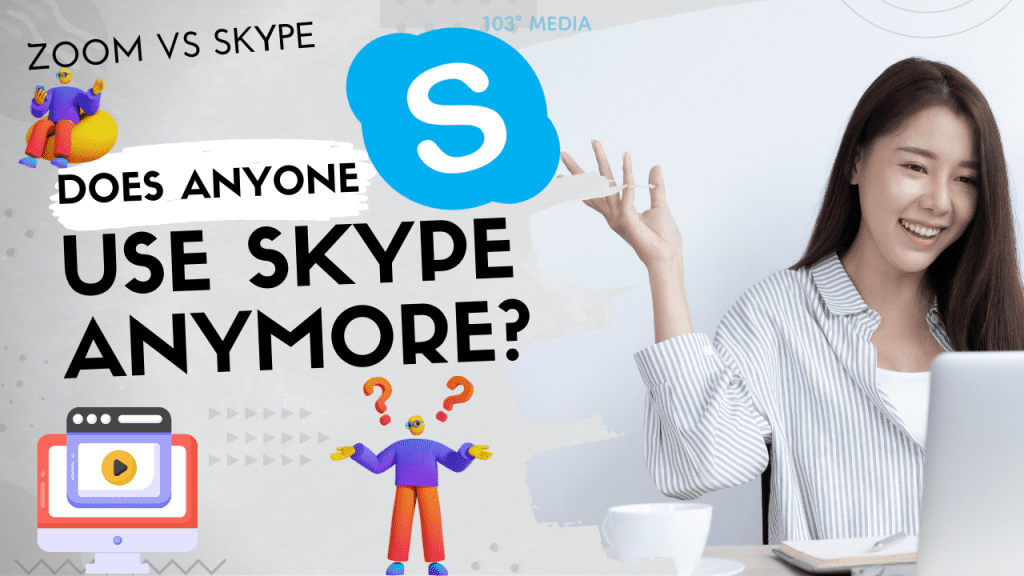The COVID-19 lockdown was supposed to be Skype’s big break, but its younger competitor Zoom has been the undisputed leader in video communications for the past two years. So, what went wrong with Skype?
What Motivated Microsoft to Switch from Skype to Teams?
In 2011, Microsoft purchased Skype. When it came to facilitating real-time collaboration between members of disparate teams located in different parts of the world, Skype quickly rose to prominence as one of the most popular Voice IP (VoIP) communication applications available.


The growth of the remote workforce enabled by improvements in mobile technology and faster, more reliable networks contributed to the tool’s popularity.
The cloud has emerged as a leading provider of reliable business solutions as the technologies enabling remote workers have matured. One such platform that enables remote collaboration is Microsoft’s SharePoint.
With the advent of Big Data and its massive amounts of data, businesses have started looking for collaborative and content management tools that Skype simply cannot provide.
With Teams, you can get everything your modern, distributed team needs. Teams are based on SharePoint and merge Skype’s video conferencing, screen sharing, and chat functions with improved file sharing and collaboration tools.
Teams’ helpful features include document collaboration, revision history tracking, and group chat.
What’s the Difference Between Zoom and Skype?
Professionals often use video conferencing services like Zoom and Skype. Skype was around first, and while it’s best known as a VoIP service for video and phone calls, it can also serve as a versatile virtual meeting tool for smaller groups or individual professionals.
Since its launch in 2013, cloud-based video conferencing and webinar platform Zoom has gained traction among businesses of all sizes.
There’s a lot of overlap between the two products, and that includes the fact that they both have free versions that are better suited to individuals and smaller groups.
Which of these two options you choose may depend on which special features are most useful for your specific group or daily tasks.
Major Differences
| Zoom | Skype |
| Free and small team plans. | Free to use with 100 participants maximum. |
| Many collaborative tools for teams. | Phone calls and texting are available for a fee. |
| Supports webinar scheduling and hosting. | Meet Now offers simple browser-based conferencing. |
| Numerous product integrations. | Live captions and subtitles. |
| Premium plans support large companies. |
Meeting and working with others is made easy with tools like Zoom and Skype. Each has its own unique selling points, but both offer free accounts with similar features like meeting space for up to 100 people and the ability to share screens, files and chat with others in the room.
You may change your mind about which platform is best for your workflows based on considerations like team size, meeting length limits, software integrations, and additional features.
While Skype is a great option for individuals and smaller groups, Zoom may be more adaptable for corporations.
The Verdict is in: Zoom is the Best Option for Large Businesses
Zoom provides an advantage with its multiple premium tiers and features made specifically for larger teams and webinars with a large participant count.
Free users have access to a tonne of features, including the ability to choose who can join meetings, make their own backgrounds, and communicate with one another. Because of these features, Zoom is a great choice for businesses of any size, including sole proprietors.
Skype could be preferable for solo entrepreneurs or small teams that don’t require elaborate setups for large-scale meetings with hundreds or thousands of attendees.
This cost-free service is great for small groups or large conference calls (up to 100 participants). Meet Now, a browser-based conferencing tool enables users to video chat with non-Skype members without the need for account sign-up or software downloads.
What went wrong with Skype?
What’s sadder is that at this point, nobody is even surprised. It seemed like a step that had been needed for a very long time. But how could something like this happen to an app that is so well-known that its name is in the OED?
How prosperous and promising must it have been for Microsoft to shell out $8.5 billion to get its megacorporation teeth into it? All right, let’s see if we can’t figure this out together.
Sure, even at Skype’s height, when it had over a billion downloads and hundreds of millions of users, it wasn’t all sunshine and roses. Because of Skype’s increasing popularity, a slew of imitators, including Snapchat, WhatsApp, and Messenger, sprang up to challenge the platform.
However, Skype’s decline began in earnest in 2013 after the launch of Windows Phone, when the service switched from using P2P networks to relying on cloud-based servers.
Obviously, that was a major breach of the app’s security. To make matters even worse, the revision was sloppy and unfocused.
As a default Windows 8.1 messenger and as part of the Xbox One package deal, Microsoft tried desperately to force the pathetic result upon the final users, but nobody liked it.
Users with more than one device are finding Skype to be nearly useless due to the lack of syncing. Microsoft, instead of addressing the problem, introduced a series of increasingly complex redesigns that only served to further perplex users.
In 2017, they finally gave up on Skype after the infamous design failure that made it look like Snapchat’s evil twin and caused tech forums to explode with frustration. Instead, they put all of their efforts into Teams.
Future of Skype
Worse yet, at this point, nobody is even surprised. As a matter of fact, it seemed like a long-overdue action. How could something like this happen to a popular app whose name appears in the OED?
So fruitful and promising that it cost Microsoft $8.5 billion to get their megacorporation teeth into it? We should work together to find an answer.
No doubt about it, even at Skype’s zenith, when it had over a billion downloads and hundreds of millions of users, things weren’t always rosy. It was inevitable that other messaging apps would emerge to challenge Skype’s dominance in the market as its popularity grew.
The real beginning of the end for Skype, however, came in 2013 with the introduction of Windows Phone, when Skype made the transition from P2P networks to cloud-powered servers.
That was a major breach in the app’s security. The new version was even worse than the old one; it lacked any sort of substance or focus.
Everyone hated it, and the Microsoft team tried to force it on the final users by making it the default messenger in Windows 8.1 and including it in the Xbox One bundle.
As a result, Skype is now practically useless for anyone who uses more than one device, which is pretty much everyone. Microsoft did not address the problem by fixing it, but rather by constantly releasing new designs that added to user confusion.
Moreover, in 2017, after the infamous failure with the design that made Skype look like Snapchat’s evil twin and caused tech forums to explode with frustration, they completely abandoned Skype in favor of Teams.
FAQs
Yes, people still use Skype. However, its popularity has declined in recent years due to the rise of other video conferencing platforms such as Zoom and Microsoft Teams. According to Statista, Skype had 300 million monthly active users in 2020, down from 400 million in 2019.




